As a homeowner, knowing the basics about your water supply lines can make a world of difference. From spotting early warning signs to explaining issues accurately to plumbers, understanding these systems empowers you to handle potential issues before they escalate.
In this guide, we’ll walk through everything you need to know about water supply lines—from the materials they’re made of to common issues, seasonal maintenance tips, and when to call a professional.
What Are Water Supply Lines?
Water supply lines are the plumbing lifelines of your home, bringing fresh water from your main supply to every faucet, shower, appliance, and outdoor fixture. Here’s a breakdown of the main components:
- Main Water Line: The primary pipe bringing water from your local source into your home.
- Water Meter: This device measures your water usage.
- Shut-off Valves: Located near each fixture, these control the flow of water so you can turn off individual lines if needed.
- Branch Lines: Smaller pipes that direct water to individual fixtures like sinks, toilets, and washing machines.
By understanding where these lines run and how they work, you’ll be better prepared to detect problems early and prevent water damage.
Types of Water Supply Line Materials
Water supply lines are made from different materials, each with its own strengths and weaknesses. Knowing which materials are in your home can help you make informed decisions about repairs and replacements.
| Material | Lifespan | Cost | Pros | Cons |
|---|---|---|---|---|
| Copper | 50-70 years | High | Durable, corrosion-resistant | Expensive, difficult to install |
| PEX | 40-50 years | Medium | Flexible, freeze-resistant | UV-sensitive, not recyclable |
| CPVC | 50-75 years | Low | Affordable, good for hot water | Can become brittle over time |
| PVC | 50-70 years | Low | Very affordable, corrosion-resistant | Only suitable for cold water |
For example, while copper and PEX pipes are popular for their durability and freeze resistance, PVC is often limited to cold-water applications. If you’re unsure about which materials are in your home, a plumber can identify and evaluate them for you.
Common Water Supply Line Issues
Even well-maintained systems can encounter issues over time. Here are some of the most common problems:
- Leaks: Leaks can range from minor drips to major floods. They may result from old or damaged pipes or loose connections.
- Frozen Pipes: In colder climates, water in pipes can freeze, causing them to burst as the water expands.
- Mineral Buildup: Hard water can leave mineral deposits in your pipes, gradually reducing water pressure.
- Corrosion: Older pipes, especially galvanized steel, are prone to corrosion, which can affect water quality and flow.
- Water Pressure Problems: Low water pressure may result from leaks, blockages, or issues with your water provider’s main line.
Signs of trouble include unexplained water bills, damp spots on walls or floors, and a sudden drop in water pressure. If you notice any of these signs, it’s best to act quickly to prevent further damage.
Seasonal Maintenance Tips for Water Supply Lines
Keeping up with seasonal maintenance can help prevent major issues:
- In Winter: Insulate pipes in unheated areas (like basements or crawl spaces) to prevent freezing. On extremely cold nights, consider letting faucets drip to keep water flowing.
- In Summer: Inspect outdoor faucets and pipes for leaks, and ensure all shut-off valves are working correctly.
- Year-Round: Schedule a professional inspection at least once a year. A plumber can check for wear, tighten connections, and assess your system’s overall condition.
By following these simple steps, you’ll help extend the lifespan of your supply lines and reduce the risk of sudden leaks.
Water Conservation Tips
Using your water supply lines efficiently isn’t just good for the environment—it can also lower your bills. Here are some easy water conservation tips:
- Fix Leaks Promptly: Even a small drip can waste gallons of water over time.
- Install Low-Flow Fixtures: These use less water without sacrificing performance.
- Use Drought-Resistant Landscaping: This can reduce outdoor water use.
- Collect Rainwater: Use it for watering plants or outdoor cleaning.
- Run Full Loads in Dishwashers and Washing Machines: These appliances use the same amount of water regardless of load size, so maximize efficiency by only running them with full loads.
Smart Home Integration for Water Management
Smart home technology can make it easier to manage your water usage and detect issues early. Consider these upgrades:
- Leak Detection Systems: These devices alert you if they detect moisture, helping you catch leaks before they become costly.
- Smart Water Meters: These provide real-time data on water usage, allowing you to monitor consumption directly from your smartphone.
- Automated Shut-Off Valves: In the event of a major leak, these can automatically stop water flow to prevent damage.
- Water Quality Monitors: These continuously test your water for contaminants, ensuring it’s safe for your family.
Investing in these smart tools can bring peace of mind and help you avoid water-related emergencies.
Considerations for Private Wells
If you rely on a private well, there are a few extra steps to ensure your water quality and supply line health:
- Test Water Quality Regularly: Check for bacteria, minerals, and other potential contaminants at least once a year.
- Maintain Your Well Pump and Pressure Tank: Regular maintenance can prevent air from entering the water line, which can cause inconsistent pressure.
- Install a Filtration System: This can help improve water quality by removing impurities that might build up in your pipes over time.
Private wells require regular attention, but these precautions can ensure a steady, clean water supply.
When to Call a Professional Plumber
Some plumbing tasks are manageable on your own, but for larger issues, calling a professional is the best choice. Consider reaching out if you experience:
- Major Leaks or Flooding: Fast response can minimize water damage.
- Low Water Pressure: Persistent low pressure might indicate deeper issues.
- Changes in Water Quality: Unusual taste, color, or odor could signal contamination.
- Outdated Pipes: Older materials, like galvanized steel, may require replacement to prevent corrosion and contamination.
Need Professional Help? Call Bear Valley Plumbing Heating and Air
Whether you need routine maintenance, urgent repairs, or expert advice, Bear Valley Plumbing Heating and Air has you covered. Our team provides reliable plumbing services, ensuring your water supply lines remain safe and functional.
For assistance with your water supply lines, call us at 909-584-4376 to schedule an estimate, consultation or service. With our expertise, you can trust that your plumbing is in good hands.
Related Content:
- 6 Reasons to Install a Water Softener to Your Big Bear Home ASAP
- 5 Practical Leak Prevention Tips from Big Bear Plumbing
- Is Liquid Plumber Safe for Pipes in Big Bear?
- How To Prevent Frozen Plumbing Pipes in Big Bear
- How’s Your Water Pressure in Big Bear? 7 Ways to Improve It Today
Frequently Asked Questions (FAQ)
What is a water supply line?
A water supply line is a pipe that delivers fresh water from the main supply to your home’s fixtures and appliances, like sinks, showers, and washing machines.
How long do water supply lines last?
The lifespan varies by material—copper pipes can last 50-70 years, while PEX and CPVC can last 40-75 years. Regular maintenance can help extend the life of all supply lines.
What are signs of a water supply line leak?
Watch for increased water bills, damp spots on walls or ceilings, low water pressure, and unusual water sounds when fixtures are off.
Can I replace a water supply line myself?
Minor repairs might be DIY-friendly, but replacing an entire line is best left to professionals to ensure proper installation and code compliance.
What causes low water pressure in supply lines?
Low pressure can be due to mineral buildup, leaks, a partially closed shut-off valve, or issues with your municipal water supply.
How can I prevent my water supply lines from freezing?
Insulate pipes in unheated areas, keep your home at a consistent temperature, let faucets drip in extreme cold, and disconnect outdoor hoses.
What’s the difference between PEX and copper supply lines?
PEX is flexible and freeze-resistant, making it easier to install in tight spaces. Copper, on the other hand, is extremely durable and naturally antimicrobial but more costly and harder to install.
If you are looking for a Big Bear plumbing, heating & air conditioning contractor, please call (909) 584-4376 or complete our online request form.
Category: Plumbing Replacement




